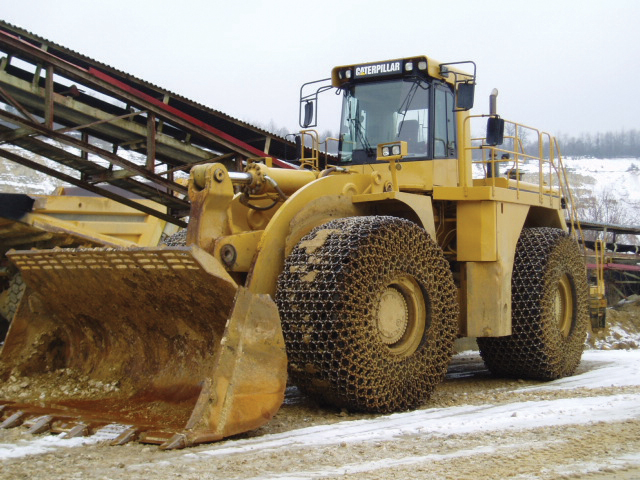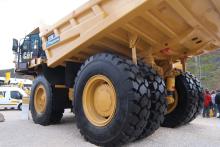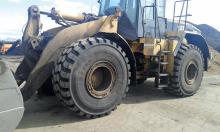
Tyres are an expensive part of equipment used in quarries and the longer they last the better as Patrick Smith reports
There is a perception that, compared to mining, quarrying is the soft side of the mineral resource industries.
Yet a quarry’s geology can be just as aggressive and demanding as winning Canadian Kimberlite, Chilean copper or Australian anthracite.
And, when it comes to load and haul, a quarry is just as likely to employ big loaders such as
Where wheeled plant is used, the efficiency of the entire operation will rest on the tyres without which the earthmovers are, quite literally, grounded, says
“It follows that, where the tyres are exposed to heavy attrition or risk terminal sidewall piercing, meeting supply contracts can depend on either stockpiling spare tyres ‘just in case’ or taking steps to protect the tyres from damage,
“Due to the raw materials (natural and synthetic rubber, reinforcing fabric, steel cord, carbon black, sulphur and silica) used in manufacturing, the energy required for vulcanising and the problems of eventual disposal, tyres have an adverse environmental impact,” claims Erlau.
“Add the facts that the larger tyres, which take up to 12 days to hand build and cure, are in short supply and expensive to own, it follows that anything that can extend their useful life is to be welcomed.
“Rather than stockpiling tens of thousands of precious tyre euros, many consider fitting TPC, the most cost-effective and lasting option.
“When everything is factored in, fitting a quality chain with a reputable pedigree can, by saving tyres, minimising maintenance downtime and increasing productivity, save as many as ten sets of tyres and reduce tyre costs by as much as 72%.”
Erlau, a division of an archetypal, family-owned German company with 140 years’ experience developing and manufacturing round-link conveyor components, is now celebrating 70 years since it introduced the first TPC.
“Over the years, working closely with many customers, Erlau has gone on to develop sophisticated, lightweight, durable alloys that, along with user-friendly components and installation methods backed by life-of-product support, offer a range of TPCs to match any challenge, be it excessive abrasion from quartzite; sidewall piercing from slate; extreme heat from foundry slag or poor traction due to clayey or icy conditions,” says the company.
It claims: “Despite technical advances in their construction, manufacturers struggle to overcome the inherent weakness which paradoxically gives tyres the advantage of flexibility and buoyancy.
“Worn tyres can be retreaded or regrooved and punctures can be repaired but, once damaged, they never have quite the same integrity.”
However, manufacturers are constantly carrying out research and development on new products, and this now includes the possibility of using dandelions in tyre manufacture.
A research team at the University of Münster, Germany, studied the latex in them and discovered they produce gum elastic, apparently equal in quality to rubber tree latex.
Automotive parts supplier
Apparently, early research results show Russian dandelions to produce a high quality natural rubber with physical and chemical properties said to match up well with those of the Brazilian rubber tree.
Indeed,
“Surface mines, quarries and cement works as well as infrastructure projects to build motorways, railways or dams, all have something in common. These operations are increasing in number around the world and articulated dump trucks (ADTs) play an essential role in their success, in all cases,” says the company.
“Articulated dump trucks, which can carry payloads that vary from 20-50tonnes, need to be extremely adaptable, versatile and able to carry materials on sometimes difficult terrain, regardless of weather conditions.”
Michelin has unveiled its X-Super Terrain + tyre for ADTs, promising enhanced safety, greater versatility and improved productivity.
“The new Michelin X-Super Terrain + reuses the most outstanding feature of the Michelin X-Super: its exceptional traction.
“To further enhance performance, the new tyre also integrates Michelin’s latest technological innovations: additional reinforcements and the latest-generation C2 casing.”
This technology is said to reduce heat build-up on the shoulders when the tyre is in use, thereby increasing tyre life due to the use of thicker, corrosion-resistant cables.
Another new product from
The new addition to Goodyear’s off-the-road (OTR) tyre range is a level 250 (L5) traction tyre for severe conditions including those in quarries, difficult industrial applications and recycling, as well as in open and underground mines.
It features hi-stability carcass technology, which combines reinforcements in the bead area, on the carcass breakers, and at the ply turn-up.
The CAD-developed tread design is also said to deliver a high level of protection against impact and shocks, as well as its powerful traction performance and longevity, particularly in tough environments such as quarrying.
Compared to the RT-5C, vibrations on hard surfaces are said to be reduced by 30% for far greater comfort.
While the quality and the performance of tyres are essential to maximise the productivity of machinery, incorrect fitments and maintenance will lead to short tyre life, poor performance and, therefore, high cost per hour.
“OTR tyres are a significant investment but without correct maintenance they will not give the expected performance and will not last long either,” says Octavian Velcan, managing director of Goodyear OTR Tyres in EMEA (Europe, Middle East, Africa).
Italian company
“In market contraction periods economies look for successful solutions contributing to the increase of their activities’ efficiencies,” it says.
“Particularly in these periods, specialised companies search for supplies that maximise reliability, working life and costs save. This aspect is very important on tyres which represent a relevant cost in the balance sheet of the companies.
“The reduction of the per-hour cost of tyres has become one of the most important factors for mines, quarries and construction sites, second only to that of worker safety.”
The company claims that “if correctly managed, even the largest tyre can be retreaded for less than 40 to 50% than the cost of a new, premium tyre without compromising the performance and reliability.”
Indian tyre manufacturer BKT‘s product lines are now extended by new sizes and, among products it highlights, is the Earthmax, a tyre with an all-steel structure designed for dumpers and wheeled loaders to ensure optimum load distribution on the terrain.
French company Phoenix Services France, Fos-sur-Mer, which provides slag handling and recycling of residuals from the Arcelor Mittal steel plant, handles about 1.2 million tonnes tons of material/year.
“For doing a good job, it is essential that tyres are absolutely resistant, not only in terms of durability but also in terms of sturdiness. They are often subject to very heavy and frequent loads,” says Michel Bertrand, in charge of production and material handling at Phoenix Services.
“The BKT EarthMax tyre line, which we have chosen for one of our wheeled loaders, enables us to do a great job. We mounted the BKT tyres, SR 30 - 26.5 R 25, and we have been operating for more than 3,000 working hours.”
BKT says it aims at achieving a 10% market share by the end of 2014 with a turnover of US$41.36 billion (€1 billion), while the long-term objective is to reach a turnover of $2 billion (€1.54 billion) by the year 2020.
Czech company
“The ERL-50 tread pattern is particularly resistant to cut and wear,” says Petr Hala, Mitas industrial product manager.
“This radial tyre is designed for durability as Mitas altered its tread pattern and incorporated steel cord in the body and breaker.”
Marangoni says its retreading technology and compounds provide a range of 267 different products that are sub-divided into 73 different sizes and 38 different patterns.
“Talking about rigid dumpers the choice can equip over 100tonne trucks and up to the 36.00R51 measure,” says Marangoni, which offers various compounds depending on the various market applications: from compounds that are especially formulated to withstand cuts, such as the W2, to those that offer a maximum amount of resistance against heat and high speed, such as the H1.
In order to manage its extensive range of products on all European markets, Marangoni relies on a network of specialists for the marketing of its retreaded EM extreme damage resistance tyres.
Marangoni’s retreads are all produced at the Rovereto facility in Italy, whose production processes were awarded with the ISO 14001 environmental certification and where, among other things, the group’s entire R&D department was consolidated into a new research centre where Marangoni offers training programmes to its clients with specific courses on knowledge of EM tyres, applications and maintenance to optimise performance.
“These factors are in fact fundamental because if professionally made the retreaded tyre can perform as a new one,” says Fabrizio Finotti, after-sales technical assistance manager.
Turning to the environment, Marangoni claims that retreading gives a tyre a second or even a third life, in some cases, which leads to considerable savings in terms of raw materials.
Monitor that tyre
With thousands of euros invested in big tyres, monitoring is another way to keep track of wear and tear.
AM Bromley’s OTR Tire Monitor System, (TMS) was showcased at
Enaikoon, a leading global telematics service provider, has joined forces with electronic engineers AM Bromley and its TMS, and they showcased the TMS and Enaikoon’s powerful tracking system.
Mandy Bromley, director at AM Bromley said,
“Our TMS offers an impressive range of sensor devices designed to keep costs low and productivity high.
“At a time when companies are experiencing increasing fuel costs and pressure on profits it makes sense to investigate the TMS proposition to drive efficiencies by optimising tyre, and therefore vehicle, performance.”
The product, developed and marketed by AM Bromley in the UK, is sold worldwide through a network of distributors, with a significant presence in South America, Europe and the Far East.
The TMS works by sending information wirelessly from sensors (there are various types) on the tyres to an in-vehicle receiver, which collects the data from all sensors and which can generate an alarm signal.
The receiver is connected to an operator interface in the cab to display real-time information to the driver. This can also be connected to a laptop for historical data viewing and alarm configuration.
Sensors transmit tyre pressure and temperature data periodically and when pressure changes.
The Enaikoon Locate-06 attached to the TMS sends data to the Enaikoon servers, which can be accessed for real-time, any time reporting.








